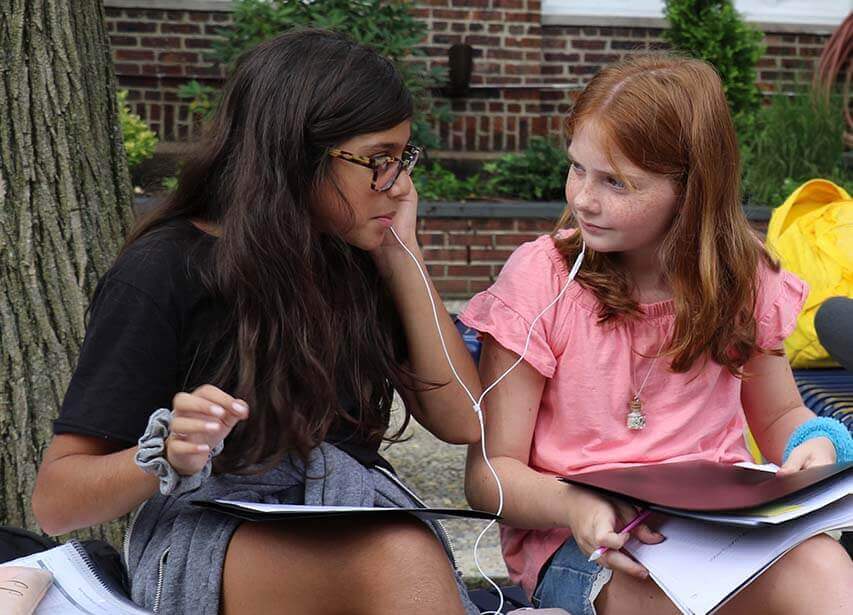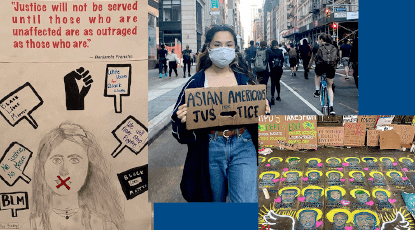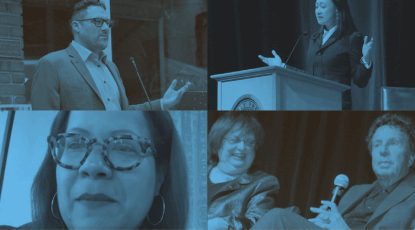PolyAcademics
Curriculum
WELCOME! OUR 2025-2026 APPLICATION WILL OPEN IN SEPTEMBER

Middle School students draw on their natural curiosity and our expansive, beautiful campus and its resources to extend their learning beyond the classroom—in clubs, athletic activities, rehearsals, art studios, and in building relationships among each other and with their teachers.
Our curriculum places a premium on intellectual development centered on creativity, critical thought, and personal growth through the embrace of risk and challenge. Courses are deliberately designed to elicit questions rather than provide answers, and students are encouraged to connect their classroom learning to events in the world beyond our campus. Find out how Middle School deans help families with curriculum options.
For more detailed information about Poly’s Middle School curriculum by grade and sequence, please see our curriculum guide.
Middle School Curriculum Guide for the 2024-25 Academic YearIn every discipline, we set standards of academic excellence aimed at fostering habits of mind that will serve our students throughout their lives. Our expectation is that students learn to read, write, analyze, and quantify with purpose, focus, and clarity. The Poly Prep Middle School curriculum sequence is expressly designed to enable our students to be agents of positive change in whatever fields and contexts they choose.
Middle School Curriculum Overview
-
Computer Science
In our Computer and Information Science classes and state-of-the-art Makerspace, students apply their creativity, problem-solving skills, and communication tools to explore new languages, engineer and design 3-D solutions, develop multi-level understanding of the internet and social media, use hands-on technologies such as robotics and microcontrollers, and explore the expanding universe of artificial intelligence.
The language of computers is one of Poly’s fastest growing and most exciting fields of inquiry, and our digital-savvy students are its natural interlocutors. Poly’s Middle School Computer and Information Science curriculum prepares students to leverage technological tools to promote efficiency and productivity in their studies, and as a means of enhancing collaboration with peers. Students in Computer and Information Science are always introduced to technology and innovations in ways that interrogate and demand an understanding of both beneficial and unintended consequences that can result from bias. Diversity, equity, inclusion, and anti-racism work is prioritized in our Computer and Information Science courses, both in content and representation. As students progress, they are introduced to the design thinking approach, and encouraged to identify real-world problems and develop credible solutions.
-
English
Madeleine L’Engle wrote that, “You have to write the book that wants to be written. And if the book will be too difficult for grown-ups, then you write it for children.” In that spirit, Poly’s Middle School English curriculum challenges as it nurtures, instilling a critical foundation for writing across an array of disciplines. Students explore a variety of writing modes, moving from the expressive to the analytical in increasingly complex forms. In addition to understanding how to transform artful sentences into well-developed essays, Middle School students read a wide range of literature, from inspiring classics like Romeo and Juliet and The Giver to the work of contemporary writers like Jamaica Kincaid, as we prepare them to write the books that want to be written.
-
History
At the core of the History Department’s mission is the belief that the study of history has the potential to, in the words of historian Carl Degler, “expand our conception and understanding of what it means to be human.” The study of history is integral to Poly’s mission of preparing students to be global citizens, and our history curriculum is designed to help students become comfortable navigating, both in the past and in the present, the tension between the familiar and the strange. To this end, students develop a deep knowledge of their own country’s history, global history, and area-specific histories. We also empower students to seek an understanding of their world that goes beyond their present moment, and to develop the empathy and humility that are integral to the thoughtful exercise of global citizenship.
-
Mathematics
Our Mathematics curriculum encourages students to become logical and imaginative thinkers. We help students recognize patterns and structures, explore multiple routes to solving problems, develop and apply critical thinking and abstract reasoning skills, and organize and explain their reasoning, both orally and in writing. As we model real-world situations and promote both deductive and inductive reasoning, our students develop the intellectual tools and confidence to persevere through complex and challenging non-routine problems, and enjoy the challenge of attempting to find the unknown and delight in its discovery.
-
Science
Our Science Department recognizes that, now more than ever before, the natural world demands innovative solutions to the most vexing environmental, medical, and resource dilemmas humankind has confronted. Our students therefore engage in experiments and analysis of observable data that challenge them to understand how science shapes all phenomena, from the manufacture of sunblock to the understanding of epidemic disease.
Middle School courses integrate the disciplines of life science, physical science, and earth/space science. In those courses, students use science and engineering practices to make sense of phenomena and design solutions to problems, preparing them to become tomorrow’s engineers, physicians, researchers, space explorers, and scientifically literate citizens. The Middle School science curriculum is built to be iterative in nature and use skills and concepts gained from the prior year as building blocks to dig more deeply and examine earth systems from new perspectives across both space and time. This integrative approach connects key concepts across scales from the atomic to the ecosystem to help students understand the interconnectedness of both abiotic and biotic systems. Through integration across scales and time, students continue to build on key competencies such as hypothesis development, data collection, and scientific reasoning in preparation for the transition into the Upper School.
-
World Languages/Classics
Our language courses immerse students in French, Spanish, Mandarin, and/or Latin as a means of nurturing their curiosity about peoples and cultures far beyond our halls, fostering understanding that transcends our own context and time. Modern language classes place a premium on speaking, sharing, and celebrating the target language, not least as a means of promoting students’ cultural competence and personal courage.
Classics courses promote deeper appreciation of the elements of spoken and written language, empowering our students to use their own language in richer, more sophisticated, and more impactful ways. Local excursions to restaurants, exhibits, and New York City neighborhoods encourage students to become intrepid and considerate citizens of the world.
-
Learning Support and Enrichment
At Poly, we celebrate the wide diversity of learning styles and are dedicated to meeting each child’s learning needs. Our learning specialists help all students to meet the demands of our curriculum, as well as become proficient self-advocates who are resilient, meta-cognitive, and strategic learners.
Our learning specialists not only work closely with students, deans, classroom teachers, and school counselors, but also oversee the Learning Center, a space for students to practice their skills and utilize a range of academic supports. We support teachers in meeting all students’ needs and enriching their learning experiences in the classroom.
-
Performing Arts
Dance, drama, and music play a central role in the experience of all Poly Middle School students. Our performing arts curriculum is an exciting combination of in-school courses and extracurricular activities, all of which build skills and encourage students to pursue their artistic interests. In grades 5 and 6, students study creative movement, drama, and vocal and instrumental music, all of which are required elements of their curriculum. In grades 7 and 8, students begin to choose from various performing arts electives, allowing them to continue their exploration and further develop their performance skills. Partnerships with professional arts organizations expand students’ horizons, and opportunities on the stage or behind the scenes enable all students to participate in our vibrant program.
-
Visual Arts
Whether they are beginners or emerging artists, students explore a range of visual arts that match their interests and skill. In our visual arts studios, art is not only hands-on and challenging, it’s also inspiring and community building. Students develop a strong base in traditional practice and materials, while being encouraged to develop their own eye and methods. They experiment, take risks, and solve problems. They look closely, ask questions, see alternate perspectives, and make connections. Through our Arts Partnerships, they meet inspiring professional artists (and arts professionals through our collaborations with cultural institutions) from whom they tap invaluable creative energy to explore and hone their own crafts. They become artists.
-
Health and Well-being
Middle school is a time of dramatic physical, emotional and social transition as students move from childhood into adolescence. Poly’s health and well-being curriculum uses an evidence based, expert informed and developmentally appropriate curriculum to support students in exploring health issues that are newly relevant to their lives. Middle school health takes a sex-positive, inclusive approach to health education that centers the health needs of people with marginalized and intersectional identities and uses harm reduction strategies to promote healthy behaviors. Health and well-being topics include sex and sexuality education, consent and healthy relationships, digial citizenship, substance use, nutrition, physical activity, sleep, and violence and injury prevention. Through hands-on activities, discussions and projects students explore how to live a way that promotes their own individual health and that of their communities. Health and Well-being classes meet once per cycle and are ungraded.
-
Physical Education
Poly Prep stresses the importance of being physically active as a lifelong goal. In our physical education curriculum, we build a foundation for ensuring a healthy lifestyle through movement. In grades 5 and 6, we focus on developing a competency in a variety of motor skills and movement patterns. In grades 7 and 8, athlete development becomes our main goal. Students have the option to choose a sport each season (fall, winter, spring) in preparation for the Upper School athletic experience.


